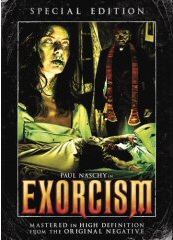
A slew of devil possession films were rushed into production by success hungry exploitation mongers after the unprecedented success of the Exorcist. A movie tight-walking the fine line between crass exploitation and serious philosophic inquiry, evoking both terror and pathos (as well as disgust and sexual taboo) by its intelligently written story of faith and damnation, The Exorcist brought to the popular consciousness a newfound respect for occult horror cinema, along with Rosemary's Baby and The Omen, all within the same era. Proving that a fear film could inspire emotional pathos as well as visceral horror and repulsion, the subject of exorcism and possession soon found their way in various Italian and Spanish features. While none of these would capture the straight drama and intellectual implications of Blatty's screenplay or Freidkin's direction, a few would match (and perhaps surpass) that film's essential sense of primal fear and moroseness. Exorcism remains one of the more aesthetically successful if commercially underrated examples of the possession sub-genre, featuring Paul Naschy at his grandstanding best. Chock full of effective gore, shocks, and physical horror, this film is most notable for evoking an aura of sinister and quite believable darkness. Rescued from a history of bad prints churned out by the gray market, horror heroes BCI add Exorcism to their eclectic catalogue of underground classics.
Co-written by Paul Naschy/Jacinto Molina (from his original story), Exorcismo achieves much of the nightmarish intensity of the original The Exorcist (with less spectacular effects) without all the moral posturing that turns many atheists or non-Catholics off. While Naschy contends that he germinated the script idea years before the Hollywood hit, the result clearly imitates the Blatty story. This is no great matter either way, as the result is a wonderfully vivid if cheap exorcise in exploitative dark fantasy. When Young Leila (Grace Mills) goes to a sex party with her boyfriend, crashes her automobile, and begins acting all around freaky, it is eventually determined that she is -- gasp! -- possessed. In a move more intimate and taboo than Blatty's vision, the spirit tormenting her is her father, who was foul and abusive to her in life. Progressing from the usual spate of foul mouthed curses and drooling to violence and sexual explicitness, Lelia becomes quite the handful, ushering in the appearance of super priest Naschy. What ensues is the expected deviltry and conflicts between rigidly set parameters of good and evil.
No stranger to traditional gothic imagery and supernatural themes, Naschy proves himself the ideal character actor to make the Priest image successful. In a plot more concerned with sensationalism than character, the director pours on mood and pseudo psychological arguments, taking full advantage of conventional supernatural underpinnings to squeeze tension and shock from his lewd story and themes. Deteriorating structures and a mysterious atmosphere externalize the terror and hatred, also mirroring the corruption of innocence and battle between faith and the demonic. Anchored in the myths of Catholicism, the speculative depth of the themes are somewhat limited by conventional religious thought and practice, but even within this narrow structure a surprisingly rich texture of exploitative jolts are managed. Appealing to devotees of bare skin and bloodshed as well as those preferring frightening atmosphere, this release from BCI is cause for Naschy fans to rejoice. Disturbing, campy, and at times surreal, the movie benefits from solid craftsmanship, haunting colors, and a story that should be admired for both its audacity and ability to build upon existing myths of religious fervour and prosecution. More importantly for fans who simply want a fun, haunting time, the filmmakers never forget their obligation to entertain, and a palpable sense of demonic titillation lurks across practically every frame. Combining demonic possession and disturbing cultural taboos with cheesy religious grandstanding, creepy music and broad acting, this wicked brew of satanic shenanigans is a satisfying chapter in Spanish horror. Incredible energy pours through both the cast and crew, and while no one re-invents the wheel here, enough of the expected clichés are subverted and/or treated with respect and innovation that the experience avoids the tedium of several more famous and more current possession fiascos (and on the budget of a few expensive dinners out!). Yes, there are several minor flaws of character logic, plot and continuity, but the depth of atmosphere more than makes up for them.
The visual perfection of this transfer is another triumph for BCI, just as clean and colorful as their first two Naschy releases were. The images of the full frame print are captured with stunning detail, and the colors are bold and deep, with no noticeable grain. Audio tracks are offered in Castilian with optional English subs, and an English-dubbed mono. Both of these are clean and free from interference.
Extras are comprehensive for this release, lending authority and subtext to the feature. There is a sense of history and biography here, including, most significantly, an interview with Naschy as he describes his involvement with the project, horror films of his era, and their aesthetic merit. An Introduction by Naschy is also included, followed by an international theatrical trailer, alternate "clothed" scenes, the Spanish beginning/end title sequences, still/poster/video photo galleries, and Mirek Lipinski's liner notes, of and in themselves brief if informative little chunks of historical and genre context.
Review by William Simmons
| Released by BCI |
| Region 1 - NTSC |
| Not Rated |
| Extras : |
| see main review |